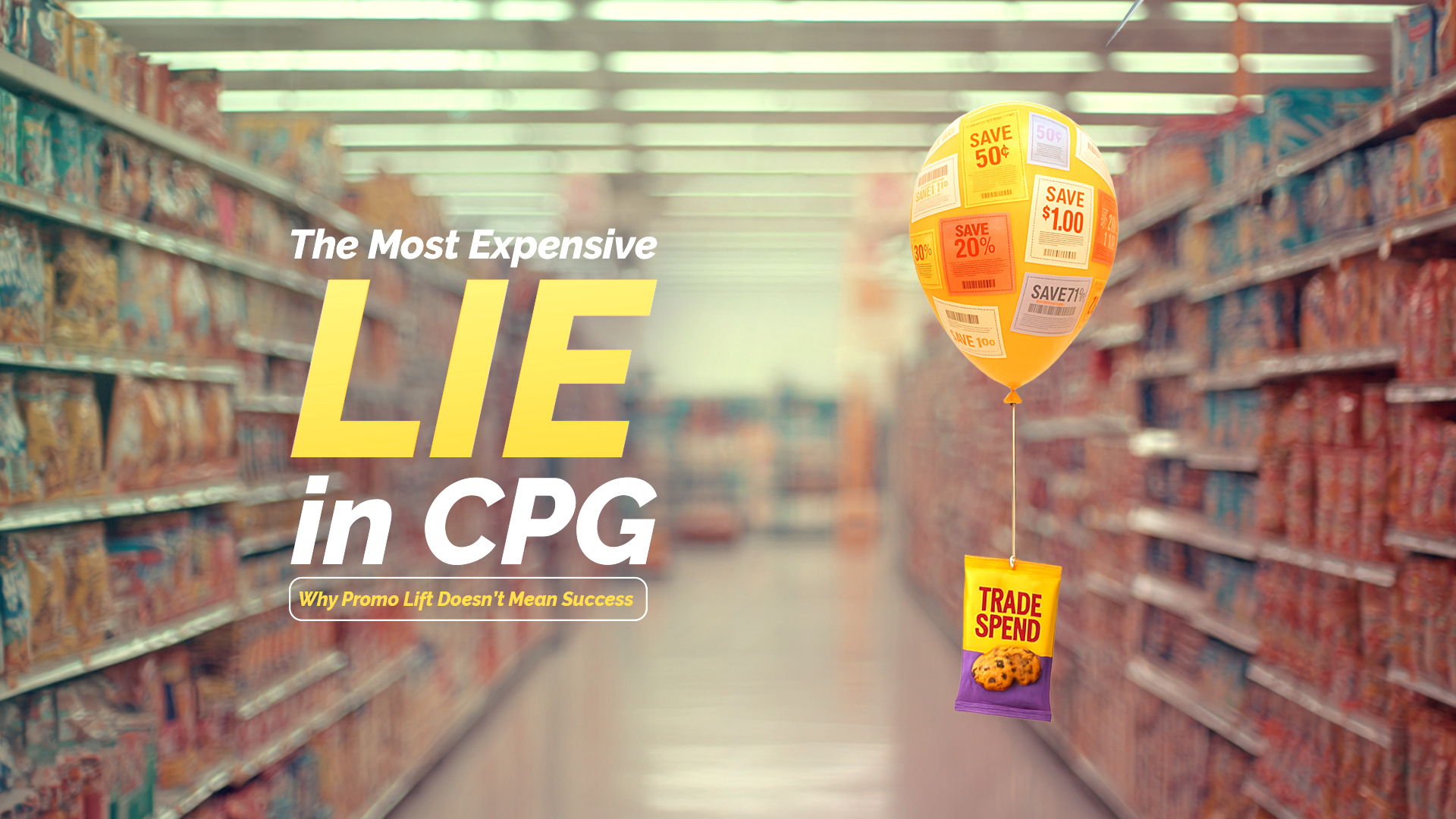The Most Expensive Lie in CPG: Why Promo Lift Doesn’t Mean Success

In the world of consumer packaged goods (CPG), few numbers grab attention like a report showing a 120% sales lift during a promotion.
Sales leaders celebrate. Marketing teams validate their spend. And without fail, the same promotion is slotted into the next quarter’s calendar.
But what if that lift is lying?
Over the past decade, we’ve seen dozens of brands celebrate promotions that actually unknowingly destroyed profitability, sometimes to the tune of six figures in wasted trade spend. The root of this problem isn’t execution. It’s measurement and analysis.
While volume might look like success, the uncomfortable truth is this:
Volume does not equal value. And when brands confuse one for the other, they can end up repeating their worst-performing promotions, over and over again.
Why Trade Promotion Measurement Needs a Reset
Let’s be clear: we’re not against sales lift. It’s a useful data point. But it’s just that, a data point. Not the whole picture.
The reality is that CPG promotions are complex financial tools. They involve variables like retail pricing, wholesale discounts, distributor margins, execution compliance, deduction activity, and so much more.
Yet most brands still judge promo success based solely on lift.
In today’s competitive retail environment where margins are pressured to the threshold of pain, deductions are the 2nd largest expense on the P&L, and promotional spend is harder to justify than ever, this outdated approach is no longer an adequate way to gauge success.
It’s time for a reset in how we measure and manage trade promotions. That reset starts with one shift: moving away from volume or revenues as the key success metric, and replacing it with incremental profit per store-week.
What Makes Volume a Lie?
Here’s a typical scenario we see far too often:
- Sales lift from a promo: +120%
- Team reaction: High-fives and scheduling a repeat of the promotion
- P&L reality: You just lit $20,000 on fire (and will do it again next year)
The reason is simple: volume metrics ignore both the visible and invisible costs that destroy true profitability. Most teams don’t realize how much erosion is happening beneath the surface.
Here are six reasons why looking at promo volume alone can be dangerously misleading:
- Pantry Loading – Consumers stock up, pulling sales forward and cannibalizing future weeks.
- Cannibalization – Gains in one SKU come at the expense of another in the same portfolio.
- Subsidy – Discounts applied to shoppers who would’ve paid full price.
- Forward Buying – Retailers and distributors inflate orders, skewing the lift data.
- Execution Leakage – Promotions are paid for but never executed correctly at store level.
- Post-Promo Dips – Short-term spikes are often followed by long-term crashes in volume and margin.
These six dynamics are not rare, they’re the norm.
But even if you factor for those and get a more accurate volume picture, you’re still just looking at volume.
But if volume was the silver bullet, everyone would spend infinite money to create volume. That’s obviously not what happens – and that’s because there’s no such thing as infinite money. The more efficiently you use the money you have available, the more volume or profit momentum you can achieve. It just depends on what your strategy is.
And unless brands are measuring how efficiently they are promoting, they’ll continue investing in promotions that appear successful but quietly destroy the value of the brand.
A Metric That Matters: Incremental Profit Per Store-Week
At Promomash, we’ve worked with hundreds of CPG brands, and here’s what we’ve found consistently: one way to know whether a promotion added sustainable, profitable growth is by measuring incremental profit per store-week.
Unlike lift, this metric adjusts for everything that matters: revenue, COGS, trade discounts, execution, deductions. It accounts for what actually happened in the market, not just what was shipped into distribution.
So how do you calculate it?
How to Calculate Incremental Profit Per Store-Week
Let’s break it down into four simple steps:
Start with total revenue during the promotion period
Subtract all costs, including:
Cost of goods sold
Trade discounts and billbacks
Retailer deductions
Divide by the number of stores that participated
Divide by the number of weeks the promotion ran
This final number tells you whether your promotion delivered true incremental profit or just moved dollars around. It’s a strategy our most successful clients take every quarter to:
- Analyze promotions for true profit impact
- Compare events by channel, customer, or product
- Flag subsidy loss, cannibalization, and execution leakage
- Align teams around one clear view of promotional effectiveness
You can do this manually, using your own sales and deduction data, or, better yet, you can let Promomash automate it.
Turning Insight into Action: How Promomash Helps
Here’s what our platform does for brands who want to make smarter trade decisions:
- Connects your sales, deduction, distributor, and retail data (via integrations with systems like Crisp)
- Calculates incremental profit per store-week automatically
- Flags promotions with poor ROI, leakage, or subsidy risk
- Provides a fully connected P&L view at the event, customer, and channel level
- Enables sales, finance, and executive teams to build calendars based on value not volume
With Promomash, your team can finally stop chasing spreadsheets and start making promotional decisions with confidence.
The Takeaway: It’s Time to Rethink What Success Looks Like
If you’re still using lift as your main KPI, you’re flying blind. Promo volume tells you what sold. Profit tells you how sustainably you sold it.
Lift looks good in a slide deck.
Profit looks good on your P&L.
An intelligent combination of the two tells your executives how efficiently you are executing and thus, how aggressively you can pursue your goals.
To win in today’s CPG landscape, you need a better way to evaluate your promotions and a better system to act on what you find.
Or, if you're not ready to crunch the numbers yourself, let's talk. We’ll walk you through how Promomash can do the work for you; automatically, accurately, and at scale.
